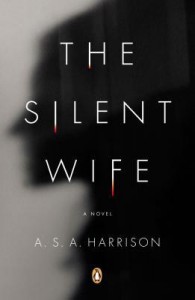 The Silent Wife by A.S.A. Harrison published by Headline
The Silent Wife by A.S.A. Harrison published by Headline
Playing Dead by Julia Heaberlin published by Faber
Dead Woman Walking by Jessica Mann published by The Cornovia Press
Crime fiction allows writers to explore the realities of marriage without having to produce the dreaded adultery novel. A murder or two, and an investigation with some serious tension generated by the heroine’s jeopardy, are small prices to pay for dramas that examine the trickiest and most important long term challenge most of us will ever face. This month sees three intriguing versions.
The late A.S.A. Harrison’s couple in The Silent Wife are not in fact married, although they have lived together for twenty years. This becomes a material fact when Todd tells Jodi that he’s leaving her to move in with the twenty-something daughter of his oldest friend, who is pregnant with his child. Todd is a property developer and has made a lot of money; Jodi is a psychotherapist, who has worked only part-time throughout their years together so that she has the time and energy to make their life and apartment as perfect as possible. She is a superb cook and obsessively tidy, with a good eye for the best of domestic paraphernalia. But, as an unmarried woman, she has no right to any share of his property, or the flat that has been her home for so long, and she does not have enough money of her own to maintain her standard of living.
Her profession has made her an expert in the various games played by people in unsatisfactory relationships, and her ideas on the subject provide a satisfying subtext to the story of hurt, revenge, and punishment. One of her clients announces that, ‘When [my husband] tells me what to do it makes me feel safe. I like the shelter of subservience.’ But in spite of everything Jodi has heard and learned, it becomes clear that she has played plenty of mind games with her self as well as the reader. The Silent Wife offers convincing psychological portraits of both a man who couldn’t keep it in his trousers and a woman who hides in plain sight. This is a delicately written novel that disturbs.
The couple in Julia Heaberlin’s Playing Dead provide a rare example of a marriage that works. Emily and Mike have, of course, had miseries and difficulties to negotiate, but they are well on their way, and Emily is pregnant at last. They have moved fromNew York City to Texas so that Mike can take up a new job. Emily misses everything about her previous life and her job as director of a SoHo art gallery but is doing her best to make the move work for both of them. She is invited to a lunch that turns out to be a kind of interview for one of the influential American ladies’ clubs that we don’t have in the UK.
Judged by the example in this novel, these clubs are the equivalent of primary school cliques, with the most popular (for which read richest, best connected, most beautifully dressed) girl in the school deciding who gets to join her playground gang, while her sycophantic followers revel in the kudos they gain from being her ‘friends’ and therefore so much more desirable than the excluded hordes. In this case, the leader turns out to be considerably more sinister than expected, so that when she disappears there are plenty of suspects.
The plot may have its absurdities, but there is a warmth and intelligence about the writing, as well as the characterization of Mike and Emily, that give the novel unusual appeal.
 Jessica Mann’s Dead Woman Walking is a more complex affair, set in various years between the Second World War and 2011. It features a group of women who all lived in the same building in Edinburgh in the 1960s and are brought together again half a century later when the body of one of them is discovered in a local quarry.
Jessica Mann’s Dead Woman Walking is a more complex affair, set in various years between the Second World War and 2011. It features a group of women who all lived in the same building in Edinburgh in the 1960s and are brought together again half a century later when the body of one of them is discovered in a local quarry.
Isabel, the first-person narrator of parts of the novel, is that familiar figure from Mann’s fiction: a woman who married too early and found the 1960s ideal of a housebound wife-and-mother quite unbearable. Isabel sums up those years in a simple comment: ‘If a personal hell awaits me, it will consist of endless journeys in a car full of screaming infants’.
Some of the other women have had their own, rather more dramatic, personal hells, which are revealed as the investigation progresses. Most interesting to me are the bookends to the narrative, in which one child is hidden on the Kindertransport train that will take her away from Nazi Germany to safety in England, and another child is taken back seventy years later. The links and contradictions involved in the two stories will stay with me.
